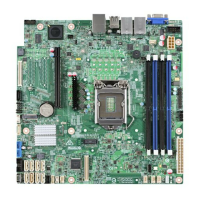Intel® Server Board S1200SP Family Technical Product Specification
57
• All Block write requests are updated into a local Memory byte array. When Byte 2 is set to Update is
Complete, the Local Memory is committed to the NV Storage. Local Memory is reset to NULL after changes
are committed.
• When Byte 1 (Block Selector = 1), firmware resets all the 64 bytes local memory. This can be used to undo
any changes after the last Update in Progress.
• User should always set the hostname starting from block selector 1 after the last Update is complete. If
the user skips block selector 1 while setting the hostname, the BMC will record the hostname as NULL,
because the first block contains NULL data.
• This scheme effectively does not allow a user to make a partial Hostname change. Any Hostname change
needs to start from Block 1.
• Byte 64 ( Block Selector 04h byte 16) is always ignored and set to NULL by BMC which effectively means
we can set only 63 bytes.
• User is responsible for keeping track of the Set series of commands and Local Memory contents.
While BMC firmware is in Set Hostname in Progress (Update not complete), the firmware continues using the
Previous Hostname for DHCP purposes.
6.11.4 Address Resolution Protocol (ARP)
The BMC can receive and respond to ARP requests on BMC NICs. Gratuitous ARPs are supported, and disabled
by default.
6.11.5 Internet Control Message Protocol (ICMP)
The BMC supports the following ICMP message types targeting the BMC over integrated NICs:
• Echo request (ping): The BMC sends an Echo Reply.
• Destination unreachable: If message is associated with an active socket connection within the BMC, the
BMC closes the socket.
6.11.6 Virtual Local Area Network (VLAN)
The BMC supports VLAN as defined by IPMI 2.0 specifications. VLAN is supported internally by the BMC, not
through switches. VLAN provides a way of grouping a set of systems together so that they form a logical
network. This feature can be used to set up a management VLAN where only devices which are members of
the VLAN will receive packets related to management and members of the VLAN will be isolated from any
other network traffic. Note that VLAN does not change the behavior of the host network setting, and it only
affects the BMC LAN communication.
LAN configuration options are now supported (by means of the Set LAN Config Parameters command,
parameters 20 and 21) that allow support for 802.1Q VLAN (Layer 2). This allows VLAN headers/packets to be
used for IPMI LAN sessions. VLAN IDs are entered and enabled by means of parameter 20 of the Set LAN Config
Parameters IPMI command. When a VLAN ID is configured and enabled, the BMC only accepts packets with
that VLAN tag/ID. Conversely, all BMC generated LAN packets on the channel include the given VLAN tag/ID.
Valid VLAN IDs are 1 through 4094, and VLAN IDs of 0 and 4095 are reserved, per the 802.1Q VLAN
specification.
Parameter 21 (VLAN Priority) of the Set LAN Config Parameters IPMI command is now implemented and a
range from 0 to 7 will be allowed for VLAN Priorities. Note that bits 3 and 4 of Parameter 21 are considered
Reserved bits.

